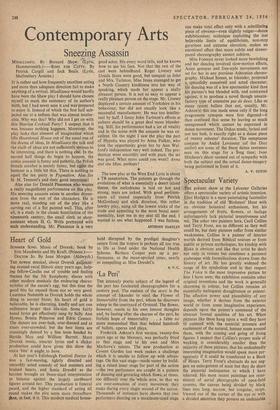`La Peri'
THE intensely poetic subject of the legend of the peri has fascinated choreographers for a century past. The essence of the story is the attempt of Iskender to steal the Flower of Immortality from the peri, whom he discovers asleep in the courtyard of Ormuzd. The flower, however, reacts to his own inmost thoughts and, by lusting after the charms of the peri, he forfeits hope of immortality . . . a fable no more nonsensical than that behind hundreds of ballets, operas and plays,
Frederick Ashton's first version, twenty-five years ago at the Mercury, was perfectly fitted to that stage and to his own and Miss Markova's talents. The new production at Covent Garden last week makes a challenge which it is unable to follow up with advan- tage. On this vast stage—made vaster by build- ing a raised inner stage for part of the action —the two performers are caught in a pattern of dancing and gesturing which flows, at times, too diffusely over the 'whole area, so that wp are over-conscious of every movement they make during every single second of the action. Thousands of instances have shown that two performers dancing on a maximum-sized stage can make total effect only with a scintillating piece of obvious—even slightly vulgar—dance exhibitionism; technique exploiting the last believable limits of equilibrium, non-stop gyrations and extreme elevation, makes an emotional effect that more subtle and slower- paced choreography cannot achieve.
Miss Fonteyn never looked more bewitching and her dancing involved slow-motion effects, Asian gestures and free-style movements not set for her in any previous Ashtonian choreo- graphy. Michael Somes, as Iskender, projected a splendidly conceived and acted character; his dancing was of a less spectacular kind than his partner's but blended with, and contrasted against, it to produce a novel though unsatis- factory type of extensive pas de deux. Like so many recent ballets (but not, usually, Mr. Ashton's) this one made sense only if the long programme synopsis were first digested—it then confused that sense by leaving so much unexpressed which cannot be expressed in dance movement. The Dukas music, lyrical and not too lush, is exactly right as a dance piece of twenty minutes' duration. The sumptuous costume by Andre Levasseur (of the Dior atelier) are some of the finest dance costumes seen on this stage for a long time; Ivon Hitchens's decor seemed out of sympathy with both the subject and the actual dance-imagery being performed in front of it.
A. V. COTON


































 Previous page
Previous page